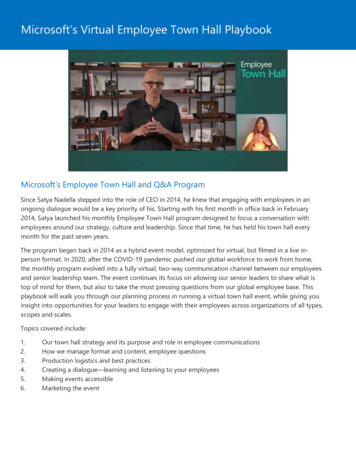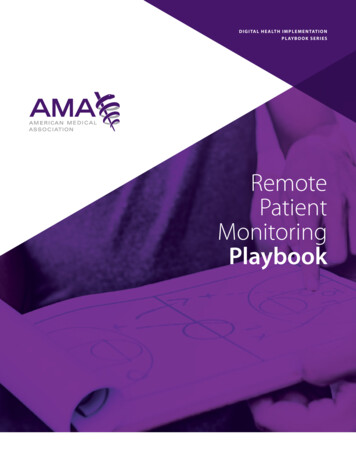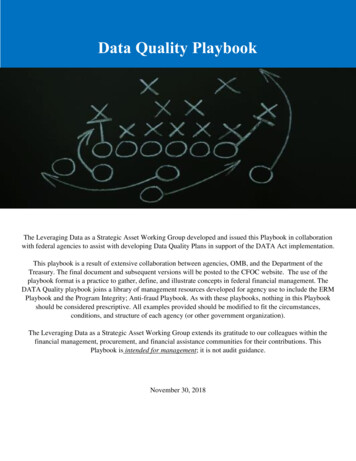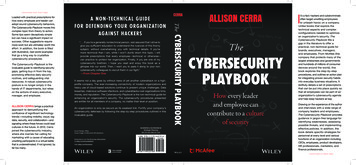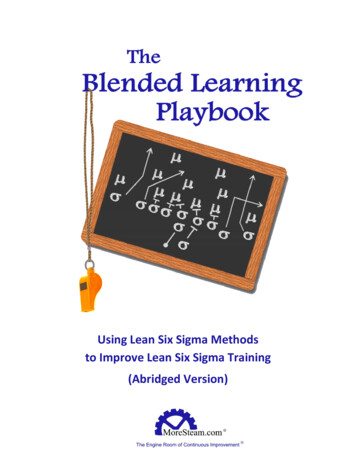
Transcription
Using Lean Six Sigma Methodsto Improve Lean Six Sigma Training(Abridged Version)
The Purpose of the PlaybookThis paper is a condensed version of MoreSteam.com’s Blended Learning Playbook, available atwww.MoreSteam.com. We developed the Playbook as a practical guide toward the design andimplementation of a Blended Learning model for Lean Six Sigma training. Lean Six Sigma deploymentsare increasingly – and successfully ‐ turning to a blended training model, but the what, how, and whyhave never been explained in detail in a single source until now.In the Lean Six Sigma Blended Learning Playbook, you will find the information you need to make thebusiness case for Blended Learning, as well as guidelines to help design a blended training model. Thisabridged version covers topics that include: What is Third‐Generation Blended Learning?Why purely instructor‐led training is insufficient and not LeanWhy is Blended Learning more effective than the traditional classroom training model?What are the main components of a blended Learning model?The Playbook features many more topics, including sections on best practices, how to build the businesscase for blended training, details on how to design the most effective training model, and real‐worldcase studies from over ten small and large deployments.What is Blended Learning?We define Blended Learning as a training model designed to increase the capabilityof Lean Six Sigma practitioners by integrating multiple delivery modes and learningactivities – generally a mix of e‐Learning, classroom exercises, coaching and project‐based applications.Well‐designed Blended Learning combines complementary learning activities to attain a defined level ofsubject‐matter mastery. A Blended Learning model uses different learning modes, designed to appealto different learning styles, and engineered to meet requirements of effectiveness, cost and flexibility.Common Blended Learning components now include interactive e‐Learning, classroom simulations forDMAIC and Lean projects, live and recorded Webinars, online or paper‐based testing, one‐on‐onecoaching, support structures such as study halls, interactive Lean Six Sigma software tools, referencesources, and (most importantly) real project work.All indicators signal that Blended Learning is gaining in usage and popularity. As far back as 1999, IBMrealized 200 million USD by moving from a traditional training model to one based on e‐Learning (Halland LeCavalier). As well as being cheaper, delivering lessons in multiple modalities also leads to stickierCopyright 2009 MoreSteam, LLC1http://www.moresteam.com
learning. Multiple studies (featured in the complete Playbook) reinforce the effectiveness of the BlendedLearning model.The most recent study released by the U.S. Department of Education showed strong trends on theeffectiveness of Blended Learning. The study reported the following key findings: Students who took all or part of their class online performed better, on average, thanthose taking the same course through traditional face‐to‐face instruction. Instruction using a blend of online and face‐to‐face elements had the largestadvantage. Elements such as video or online quizzes do not appear to influence the amount thatstudents learn in online classes, whereas the greater time on task and additionalmaterials provided in online instruction did bring a greater benefit to students. Online learning can be enhanced by giving individual learners control of theirinteractions with media and prompting learner reflection and self‐assessment. The effectiveness of online learning approaches appears quite broad across differentcontent and learner types.The Third Generation of LSS Blended LearningThird‐generation Blended Learning (3GBL) is the most advanced Blended Learninginstructional model. More than just e‐Learning and classroom time, 3GBL isdesigned to take advantage of the latest technologies, including innovative projectsimulations, collaborative activities, self‐directed study and structured Master Black Belt(MBB) interventions. 3GBL frees experienced Belts to focus on live coaching and mentoring,and prioritizes project completion.In 2008, what we consider the Third Generation of Blended Learning (3GBL) arrived (shown below).With its emphasis on realistic simulation‐based practice, 3GBL has dramatically reduced the requiredface‐to‐face class time (for sizeable cost savings) while re‐characterizing the remaining classroomsessions toward group‐oriented practice instead of lecture.In the 3GBL model, most information is online, and lessons and tools are tightly integrated with projects.Other components, such as virtual coaching, Web and social networking, live and recorded Webinars, in‐class simulations, study halls, and self‐directed learning, all round out the educational experience. Thesetechnologies, when combined with the best of the old, live teaching practices, provide a new generationCopyright 2009 MoreSteam, LLC2http://www.moresteam.com
of students with a variety of flexible, engaging tools that promote self‐paced learning and criticalthinking.The Benefits of Blended LearningWhile successfully integrating the many online and live components of a Blended Training can be achallenge, the benefits far outweigh the technical and logistical issues. The Blended Learning modeloffers advantages in almost every way: lower costs, enhanced flexibility for students and instructors,more opportunities for practice, higher effectiveness, greater consistency of teaching, optimization ofyour staff and educational resources, and a stronger alignment with your strategic goals.Blended Learning Lower CostThe most obvious benefit of Blended Learning is the cost savings. Byminimizing expensive face‐to‐face instruction and travel, as well as eliminatingthe direct costs of printing and shipping training materials, the blended modelusually offers a cost advantage of at least 50%. A good rule of thumb is totarget a minimum 50% travel reduction, which should more than offset thecost of e‐Learning, and virtually guarantee a net cost savings for the revised training model. If travel canbe reduced further, the savings accelerate. The differential of these direct, hard costs is easy to measure.Other cost benefits that are present but harder to quantify include: reduction of administrativeoverhead for scheduling classes, the benefit of free, on‐demand e‐Learning reference resources, timelyCopyright 2009 MoreSteam, LLC3http://www.moresteam.com
access to training, greater scalability, and project benefits that accrue when belts are more capable.Considering the soft savings on top of the hard savings, there is complete certainty that the blendedmodel has a far lower cost structure. By reducing the consumption of physical resources, particularly fortravel, online training is also “Green” training!Blended Learning Enhanced FlexibilityBlended models are more flexible for students, instructors, and organizations. The e‐Learningcomponent features a batch size of one, so participants can start at any time with no lead time. Evenwhen waves of students begin at the same time, the online portion of the model is self‐paced, whichresults in a faster path to self‐sufficiency for training graduates.Professionals like to be in control, and Blended Learning allowsthem a larger role in to deciding the when, what and where of theirstudies. Students can also focus on the areas of knowledge that aremost difficult and revisit those lessons as often as needed. BlendedLearning caters to the individual, and the mix of components works to minimize differences inbackground, learning ability, and priorities that can become an issue in the classroom. Students can takebreaks as they need rather than mentally “checking out” as they can do in a classroom setting.Blended Learning More PracticeA training model using a blend of delivery modes and activities can shift the balance significantly in favorof practice – up to 60%, as shown below:A critical aspect of the blended model is the nature of the classroom event: the classroom experience isnot just a smaller dose of the same lecture‐based instruction. Instead, the character of the classroomexperience is changed to a practice‐based workshop with emphasis on learning by doing rather thanlearning by listening. Graduates of training models that emphasize practice are better prepared tocomplete projects, and this accelerates the rate of project completion.Copyright 2009 MoreSteam, LLC4http://www.moresteam.com
Blended Learning Higher EffectivenessHow effective is Blended Learning? An emergingbody of evidence indicates that Blended Learning issubstantially more effective than classroom trainingalone. In 2006, the Advanced Distributed LearningInitiative (http://www.adlnet.gov/), which is fundedby the Department of Defense (DOD), conducted a meta‐analysis of 96 research reports examiningresults of 26,460 people taking 208 different training courses (Sitzmann, Kraiger, Stewart, & Wisher,2006). Meta‐analysis, a technique for combining the results of multiple experiments, can help to reveallarger trends that may not be evident from an analysis of one or a small number of discrete studies.A summary of results is presented below:Across all studies, the results indicated that combining classroom and Internet components wasmore effective than stand alone Classroom Instruction for teaching job‐relevant knowledge andskills. Blended Learning was 11% more effective than Classroom Instruction for teaching bothdeclarative and procedural knowledge.Blended Learning Greater ConsistencyStudents share a common learning experience when thecourse content is delivered via a systematic medium. Eachstudent gets the same amount of content, in the same order,to the same depth. This is critical when a deployment spanscountries and time zones. Instructors bring to bear theirindividual strengths and weaknesses, and for better or worse, they tend to tailor course materials totheir own experiences.E‐Learning conveys a reliable and consistent message to all students, effectively eliminating the issueof instructor variability, a flaw inherent in training models that use multiple instructors with differentbackgrounds and levels of experience.Blended Learning Optimized ResourcesConstraints in training resources can have a severe impacton the efficiency of a training program. Over‐tasked MasterBlack Belts (MBBs), over‐booked training centers, andoverlapping waves of Belts can lead to staff burnout andmissed deadlines. In particular, Blended Learning models canmake life easier for the instructors and students whilealleviating the stress on limited physical resources.In a Blended Learning model, most or all of the “lecture” phase of training is conducted online throughinteractive e‐Learning tools. Classroom time is generally halved, relieving the stress on training centers,training technology (e.g., projectors, desktop catapults and laptops), and the travel budget. InexpensiveCopyright 2009 MoreSteam, LLC5http://www.moresteam.com
tools such as online forums, Webcasts, and phone conferencing deliver learning and coaching at a moremeasured pace and a fraction of the cost.MBBs are freed from classroom time to spend more of their intellectual capital on coaching peoplethrough project completion. They accelerate projects and focus on savings, doing more good in lesstime. The MBB‐student contact is limited to value‐add coaching sessions, study halls and regularmeetings and workshops. Deployment experts are no longer devoted to lessons, slide deck creation,classroom logistics, paper‐based material distribution, and other non‐value‐added activities.Blended Learning Better AlignmentA flexible training model that blends coaching with e‐Learningand classroom activities provides a deployment with the abilityto align learning goals with organizational strategy andcompany culture. E‐Learning, which can be customized to thelook, feel and functional orientation of any organization, candeliver company‐specific case studies and documents like mission statements, strategic objectives oreven leadership presentations.What Does a Blended Learning Model Look Like?Blended Learning is not a hodgepodge of online and live activities that have no relationship or logicalsequence. Like baking a cake, designing a training program requires the right ingredients, with the rightproportions, at the right time, processed in the right way. The table below describes the keycomponents of a Third‐Generation Blended Learning program.KeyComponentsPurpose /FeaturesCommentsInteractivee‐LearningEffective onlinecourses with easynavigation, quizzesand interactiveexercisesHigh‐quality e‐Learning includes clear explanations, real‐world examples,ample opportunity for student practice, easy access, features to supportmultiple learning activities, the ability to customize the look, feel andcontent of the course, and the capacity for progress monitoring by thedeployment leader.Simulations forDMAIC and LeanProjectsProvide real‐worldpractice in a virtualworldSimulations are the critical bridge between learning and doing, knowingand showing (see below for more information on simulations).Live and RecordedWebinarsShare past projectsuccesses and bestpractices with currentstudentsCritical to the longevity of an organization's Lean Six Sigma program is howknowledge is stored and made accessible to future waves of Belts. Byrecording sessions like teleconferences and even tollgate reviews, projectdata and past projects can be reviewed and perpetuated as best practices.Online or Paper‐based TestingMonitor students’understanding andAdult learners enjoy the instant feedback that a quiz score gives. Usetesting to give students, managers and administrators a progress report ‐Copyright 2009 MoreSteam, LLC6http://www.moresteam.com
KeyComponentsPurpose /FeaturesCommentsprovide feedbacknot a final grade.One‐on‐oneCoachingEither in person orvirtually, includingproject tollgatesThere is no substitute for a healthy mentoring relationship. Schedule (andkeep) regular meetings with students as they work through projects.“Study Hall”Catch‐up days withonline check‐ins andgroup discussionThis kind of just‐in‐time training relieves students of some of the pressureassociated with self‐paced programs and helps develop their timemanagement skills.Downloadable LeanSix Sigma ToolsOnline templates andsoftware programsHigh‐quality e‐Learning courses should have the tools and templates thatstudents need available online in a central location or tied to the specificlessons. Students will use these for their practices and projects, anddeployments benefit through the standardization of tools.High‐qualitySupport LiteratureBooks and references(especially the oneyou’re reading now!)There are many good hard copy and online texts and handbooks on Leanand Six Sigma. Find a few that align with your organization's applicationand keep them around for student references. Many students feel morecomfortable with a book for just‐in‐case situations.As you can see, much of Third‐Generation Blended Learning is delivered virtually using advancedasynchronous e‐Learning (recorded or online, non‐live components). Because the e‐Learning curriculumcommonly covers the complete body of knowledge, it must be interactive, realistic and practice basedin order to properly challenge and captivate the students. For Lean Six Sigma training, this practice cancome in the form of interactive exercises, process simulations, quizzes, and even a simulated DMAICproject.MoreSteam’s experience suggests the optimal classroom practice becomes a vehicle to move beyondcompetence to confidence, a necessary attribute of capable and successful project leadership.MoreSteam believes:Capability Competence x ConfidenceA Blended Learning Case Study: Quest DiagnosticsQuest Diagnostics offers the most extensive clinical testing network in the United States, and alsooperates laboratories in Mexico, the United Kingdom and in India. Quest Diagnostics presently offersover 3000 tests in Clinical Pathology and Anatomic Pathology, includes over 3000 Patient ServiceCenters (PSC), and tests over half a million patients each day and 150 million patients a year. In 1999,company leaders had the foresight to begin to implement Six Sigma, beginning a journey ofcontinuous improvement that resulted in 1.4 B in hard savings in the first nine years.Copyright 2009 MoreSteam, LLC7http://www.moresteam.com
For the first five years of the program, Quest Diagnostics relied on an external consulting firm forlive classroom training. In 2005, when Denis Gallagher was named VP of Six Sigma, the programadvanced considerably. Quest Diagnostics shifted to a classroom program taught by internalinstructors, broadened their initiative to include Lean Supply Chain andQuest DiagnosticsLean in the Lab, and undertook a modernization of its Lean Six Sigmatraining.Business: ClinicalTestingAs interest in Blended Learning developed, Quest Diagnostics ran apilot program in 2005 after a business case emphasized the potentialtravel cost savings (a 50% reduction) for Black Belt and DFSS training.Green Belt training, which was locally taught by Master Black Belts,was not a target for savings and so was excluded from the pilot.Following a successful trial that year, the company instituted blendedBlack Belt training, blended DFSS training and a virtual, instructor‐ledBalanced Scorecard training.2008 Revenue: 7.25BHeadquarters:Madison, New Jersey,USANo. Employees: 40,000Began 6S Deployment:Doug Evans, Master Black Belt and former Director of Lean Six Sigma1999training at Quest Diagnostics, played a decisive role in the conversionBegan Blendedfrom traditional classroom to a blended approach. “We wanted theLearning: 2005existing training to be ‘cutting edge’ and less expensive, but not at aMarket Character:sacrifice in quality,” he explained. “Our training needed to be moreflexible with respect to schedule and the learner’s ability, to beconsistent with respect to material taught and instructor’s ability, and to have a higher level ofquality and retention. Blended Learning became the right solution for us.”Supplemented by the e‐Learning, the live Black Belt training declined from 4 weeks to 2 weeks, andthe live DFSS training went from 2 weeks to 1 week. Cognitive skills ‐ thinking and reasoning ‐ arenow taught online, with the classroom time dedicated to practice and application. The new programbegins with a class kickoff meeting that helps to manage expectations and explain QuestDiagnostics’ Blended Learning model. The courses feature mandatory ten‐hour ‘training days” thatcombine self‐directed study, Web conferencing, and group conversations. Students have directexposure to Master Black Belts and instructors during the training days, classroom time, andscheduled meetings.The conversion was not without its hiccups. “Initially, the time wasn’t carved out on people’sschedules for the training,” said Evans. “I literally had to create the training days for students. Idirectly engaged the managers in the scheduling, asking them to allocate one day a week that thetraining had to occur on for their employees. This interrupted the autonomy and flexibility of theonline training, but as I explained to new students, they could still go at their own pace in theirdedicated time. The training days became a standard part of the program and helped propel theoverall success of the blended training.”“The resulting blended program is less expensive, more effective, and more flexible than theinstructor‐led classes it replaced,” Evans confirmed. As predicted, over 350,000 has been removedannually from travel expenses. Pre‐ and post‐implementation tests showed a 22% increase inCopyright 2009 MoreSteam, LLC8http://www.moresteam.com
retention of the blended material over the instructor‐led material. 85% of the learners liked the newblended approach, and 100% liked the virtual, instructor‐led training. As for flexibility, the newblended model means that Quest Diagnostics can supply learning on demand with a low lead timeand no geographic constraints. In late 2008, Quest Diagnostics added a blended course option inaddition to the existing classroom Green Belt training.Summary: Training For SuccessThe Blended Learning model is essentially a Lean Six Sigma approach to Lean SixSigma training. It removes the waste and limitations found in the traditionalinstructor‐led classroom training model, yielding higher effectiveness at lower risk,and a dramatically lower cost structure. So why do Lean Six Sigma deploymentscontinue to deliver training using an inflexible batch method that also carries thehighest cost?And why don’t Lean Six Sigma training deployments offer more practice‐based activities that simulatereal‐life problems? When students are thrust into real‐world situations, without the benefit of real‐world practice, they are often overwhelmed and ineffective. This delays the valuable results they arecharged with bringing about and leads to a negative attitude about Lean Six Sigma. In a BlendedLearning model, concepts and tools are self‐paced, time is built for reflection, mistakes are made andconfidence is built. The model shortens the learning curve and accelerates students’ results.For all these reasons, Blended Learning has become the best‐in‐class approach to Lean Six Sigmatraining. Third‐Generation Blended Learning provides new students with more engaging and flexibleways to learn. It provides deployments with more efficient, effective and standardized methods toeducate their professional work force.Your Next StepsWe hope that this abridged version has helped to whet your appetite for Blended Learning. To learnmore about how Lean Six Sigma blended training can be employed within your organization, or toreceive the complete Blended Learning Playbook, please contact MoreSteam.com at 1.614.310.1080 orsales@moresteam.com.MoreSteam.com is the leading provider of online Lean Six Sigma andDFSS training and deployment support resources. MoreSteamsupports Blended Learning through its e‐Learning courses andinnovative online project simulations. Our Web site,www.moresteam.com, offers a wide variety of free Lean Six Sigmaand Blended Learning resources.Copyright 2009 MoreSteam, LLC9http://www.moresteam.com
In the Lean Six Sigma Blended Learning Playbook, you will find the information you need to make the business case for Blended Learning, as well as guidelines to help design a blended training model. This abridged version covers topics that include: What is Third‐Generation Blended Learning? Why purely instructor‐led training is .



